Blighted By Slugs? Dan Ori Suggests These Plants Are Generally Resistant


Elizabeth is a Permaculture Garden Designer, Sustainability Consultant and Professional Writer, working as an advocate for positive change. She graduated from the University of St. Andrews with an MA in English and Philosophy and obtained a Diploma in Applied Permaculture Design from the Permaculture Association.
Reviewed By DAN ORI

Dan has over 27 years’ under his belt caring for plants and gardens. Working as a Horticultural Instructor and Consultant, he draws on a diverse range of experience that includes working as a Head Gardener, Tree Surgeon, Garden Centre Trouble Shooter, and writer of academic papers. Dan has a Level 3 Diploma in Horticulture and is currently a candidate for the RHS’s most prestigious award – The Master of Horticulture.
IN THIS GUIDE
- 1) Ajuga reptans
- 2) Alchemilla mollis
- 3) Allium
- 4) Aquilegia vulgaris
- 5) Astilbe
- 6) Astrantia major
- 7) Borago officinalis
- 8) Campanula
- 9) Cichorium endivia
- 10) Symphytum officinale
- 11) Cyclamen hederifolium
- 12) Digitalis purpurea
- 13) Erigeron karvinskianus
- 14) Euphorbia
- 15) Ferns
- 16) Fuchsia
- 17) Geranium
- 18) Hellebore
- 19) Heuchera
- 20) Hydrangea anomala subsp. petiolaris
- 21) Anemone japonica
- 22) Lavandula angustifolia
- 23) Tropaeolum majus
- 24) Penstemon
- 25) Pulmonaria
- 26) Salvia rosmarinus
- 27) Saxifraga × urbium
- 28) Sedum
- 29) Sempervivum
- 30) Stachys byzantina
- References
Slugs can be a real pain for some gardeners, especially those that live in areas with a lot of precipitation.
However, even where slugs are found prolifically, it is possible to have a beautiful and productive garden.
The first thing to remember when gardening and coping with slugs and snails is that we do want some of these creatures in our gardens.
No matter how much of a pest they may seem, they are still an important part of the food chain and crucial to the local ecology.
If we have some slugs around, then you should also have some of the creatures that eat slugs, which will keep their numbers down.
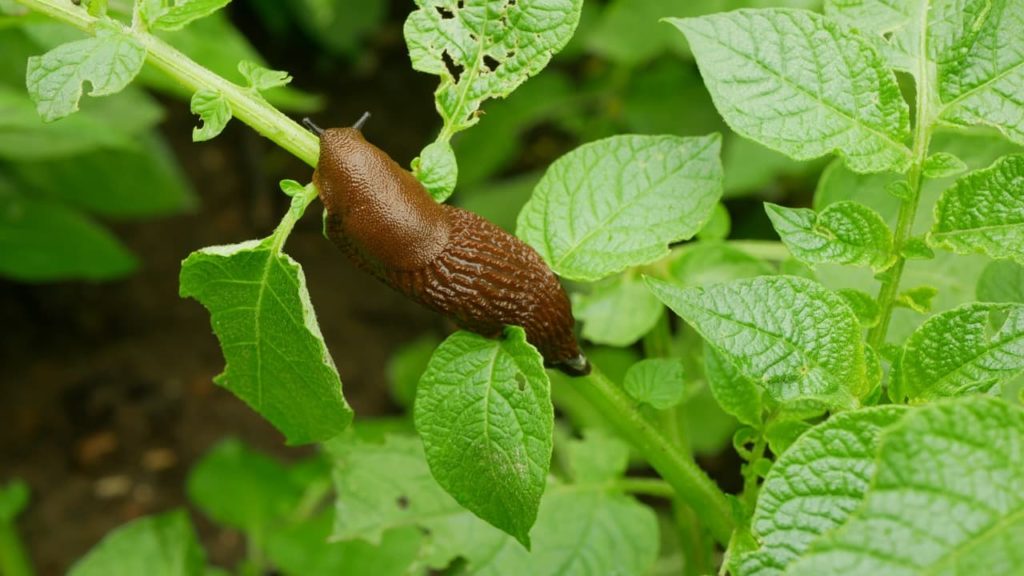
So, the best way to deal with a slug problem in an organic garden is to welcome in as much wildlife as possible – to boost biodiversity and also attract the predators that help to keep the local slug population under control, so they don’t munch their way through your precious plants.
However, in most organic gardens where slugs are found, you will have an odd problem here or there with these pests.
Fortunately, there are plenty of plants that slugs will not find appetizing at all, which will be perfectly safe with these creatures around.
I tend to find that most trees, shrubs and grasses will not be troubled by slugs at all, but when it comes to herbaceous plants, you may need to be more selective.
Here are thirty plants that, in my experience, slugs won’t eat (or are far less likely to munch on) that you might consider for your garden:
1) Ajuga reptans
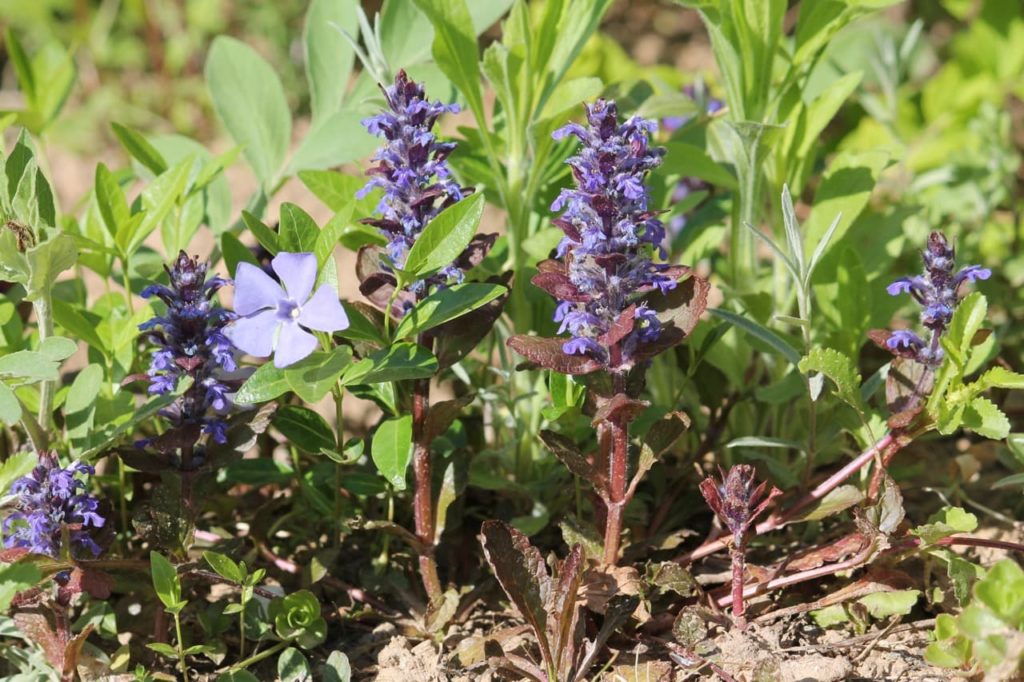
- COMMON NAME(S): bugle
- HARDINESS RATING: H7
- FOLIAGE: evergreen
- FLOWERS: blue
- SUNLIGHT: part shade
A great plant for shade, Bugle has robust foliage that won’t typically be favoured by slugs, as well as attractive flowering spikes that bloom from late spring to mid-summer.
It will work well on the ground as ground cover or even in containers where slugs may have been a problem.
2) Alchemilla mollis
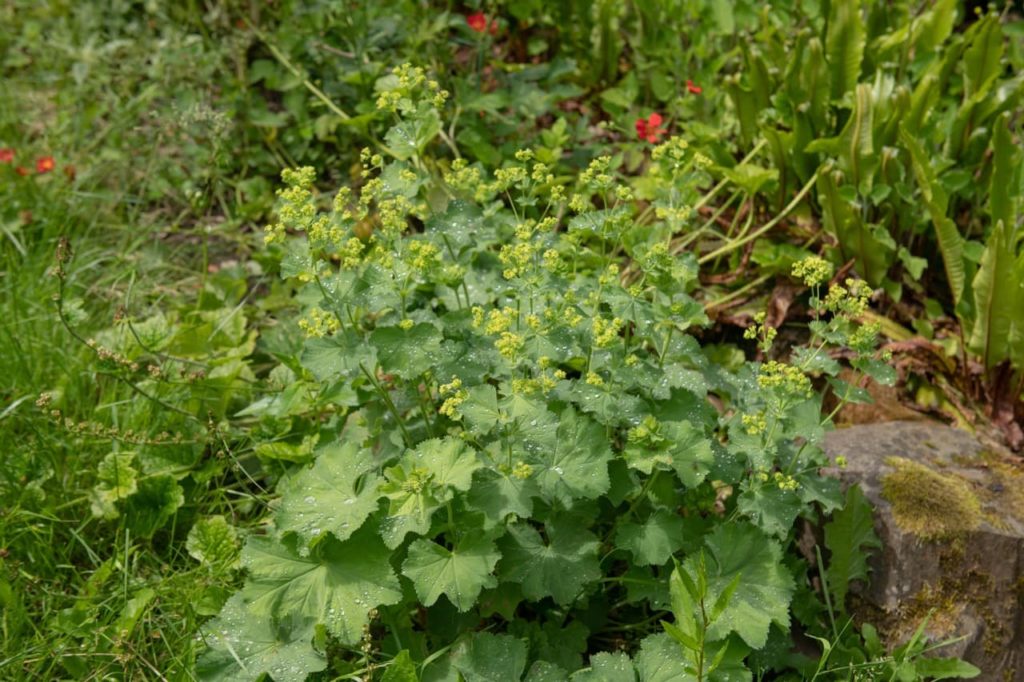
- COMMON NAME(S): lady’s mantle
- HARDINESS RATING: H7
- FOLIAGE: deciduous
- FLOWERS: yellow
- SUNLIGHT: full sun / part shade / full shade
Lady’s Mantle, as this plant is commonly known, can be a good, low-maintenance choice for a range of settings.
It makes wonderful ground cover in sun or shade and is generally another option that is untroubled by slugs.
Gardening expert Dan Ori shares that this subtle but attractive plant will thrive in a wide range of growing conditions:
“I find Alchemilla particularly useful as an alternative to Hosta which are often decimated by slugs.”
3) Allium
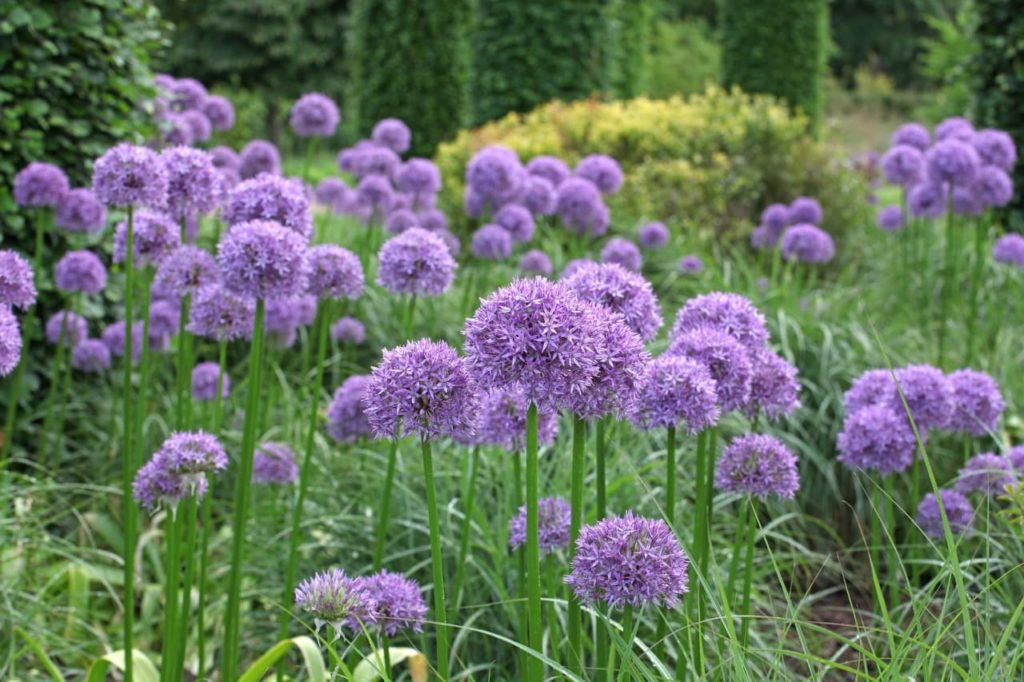
- COMMON NAME(S): ornamental onion
- HARDINESS RATING: H6
- FOLIAGE: deciduous
- FLOWERS: purple
- SUNLIGHT: full sun / part shade
Alliums in flower beds or in a vegetable patch also tend to be avoided by slugs in a garden.
Their strong taste and pungent smell discourages these garden pests where other more palatable plants are available.
“Although there has not been extensive study into slug reactions to Alliums, our best understanding is that the sulfuric compounds in Alliums are unpalatable to them,” explains Dan.
Therefore, ringing a bed with onions or garlic can help to keep slugs and a number of other pests out of a vegetable garden.
4) Aquilegia vulgaris
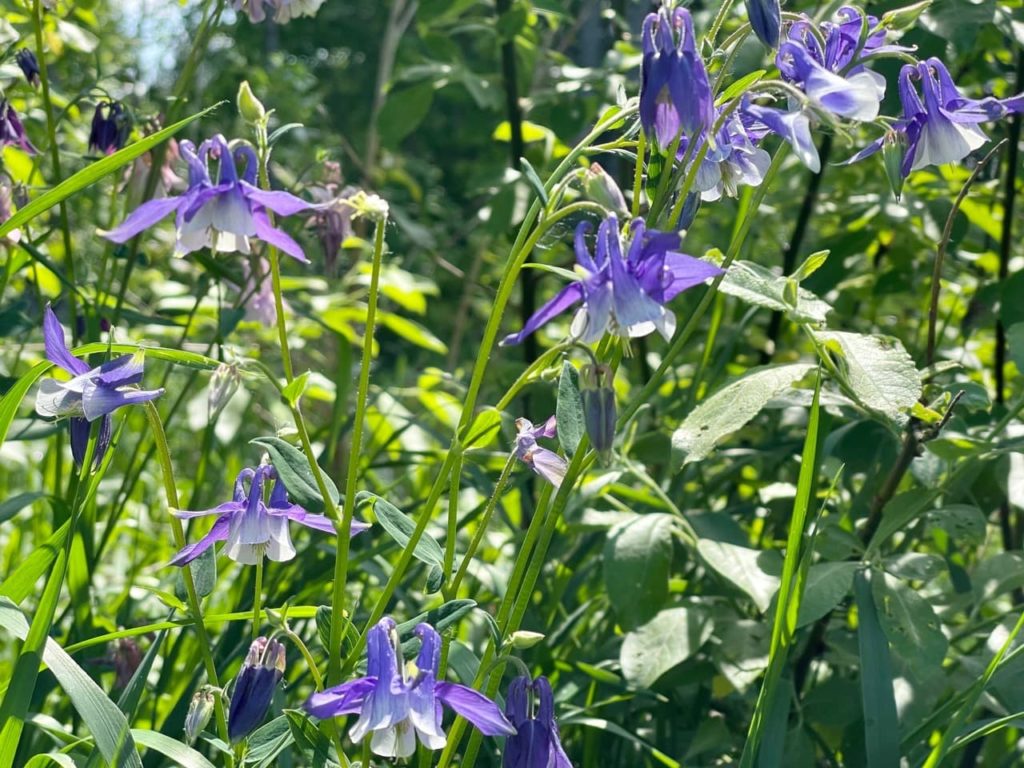
- COMMON NAME(S): common columbine
- HARDINESS RATING: H7
- FOLIAGE: deciduous
- FLOWERS: blue and purple
- SUNLIGHT: full sun / part shade
Aquilegia is a shade-tolerant option that will not tend to be bothered by slugs, so could be a good choice for naturalistic planting in dappled shade.
Another good thing about Aquilegia is that it self-seeds readily.
5) Astilbe
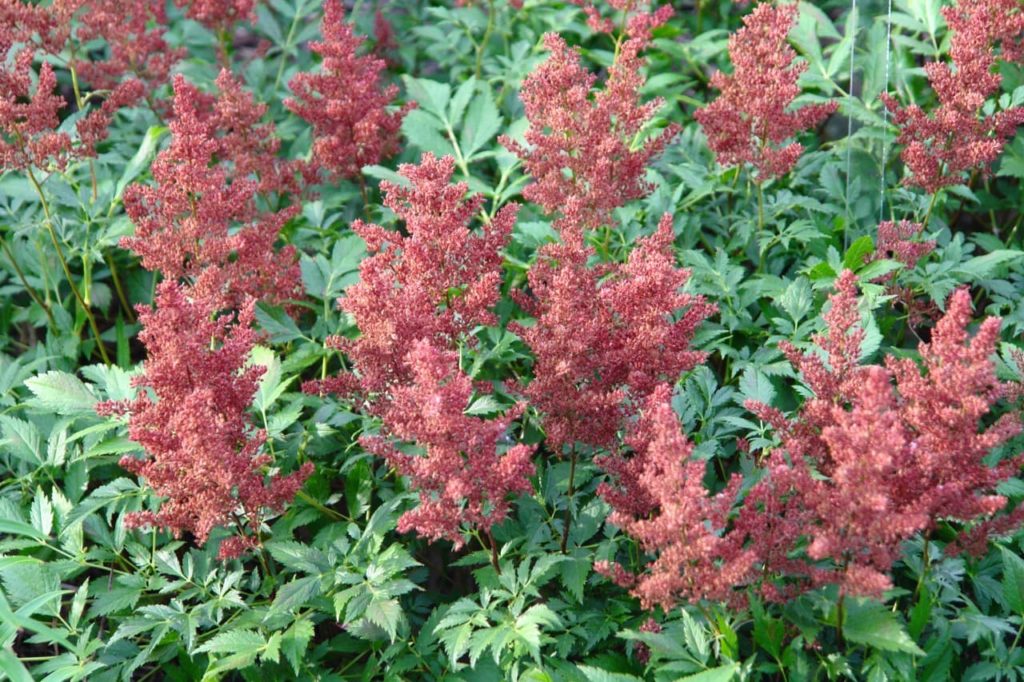
- COMMON NAME(S): astilbe
- HARDINESS RATING: H7
- FOLIAGE: deciduous
- FLOWERS: pink, white and purple
- SUNLIGHT: part shade / full sun
The vibrant plumes of Astilbes really brighten up a shady spot and, fortunately, the slugs that might also congregate in such shady areas will not tend to go near them.
These dramatic plants add height to growing areas and are typically largely hassle-free when grown in the right location.
6) Astrantia major
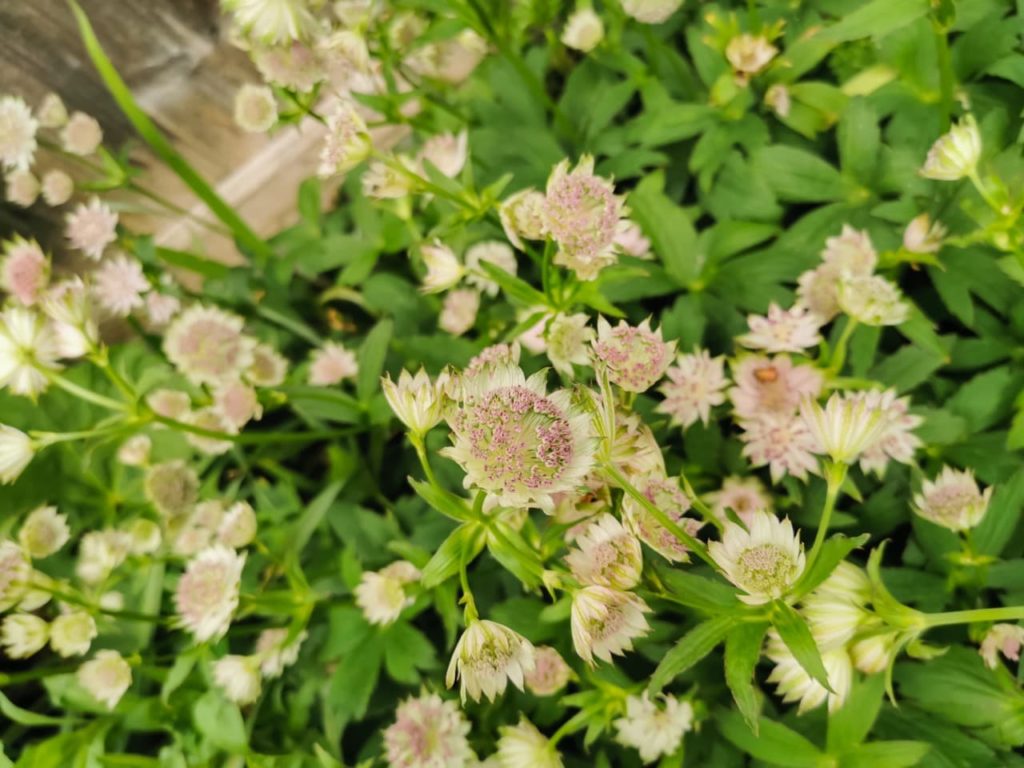
- COMMON NAME(S): greater masterwort
- HARDINESS RATING: H7
- FOLIAGE: deciduous
- FLOWERS: green, pink and white
- SUNLIGHT: full sun / part shade
Another great plant to position under trees in a moist soil, Astrantia major is another plant commonly considered to be slug-proof.
Their leaves are typically ignored by slugs, while their flowers attract plenty of bees and other pollinators.
7) Borago officinalis
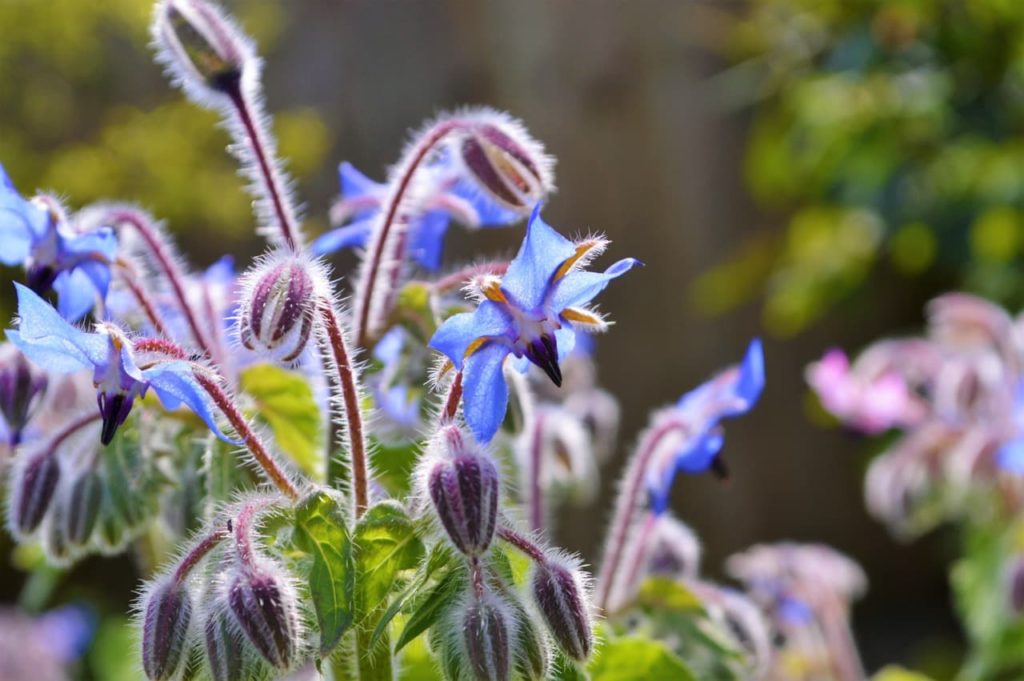
- COMMON NAME(S): borage
- HARDINESS RATING: H5
- FOLIAGE: deciduous
- FLOWERS: blue
- SUNLIGHT: full sun / part shade
Borage has furry foliage that can fortunately be off-putting to slugs.
Therefore, plant Borage in your vegetable garden and it may help to deter slugs from damaging the tastier, more tender young vegetable crops beyond.
Borage can also be useful in an ornamental bed and it is edible as well as beautiful.
8) Campanula
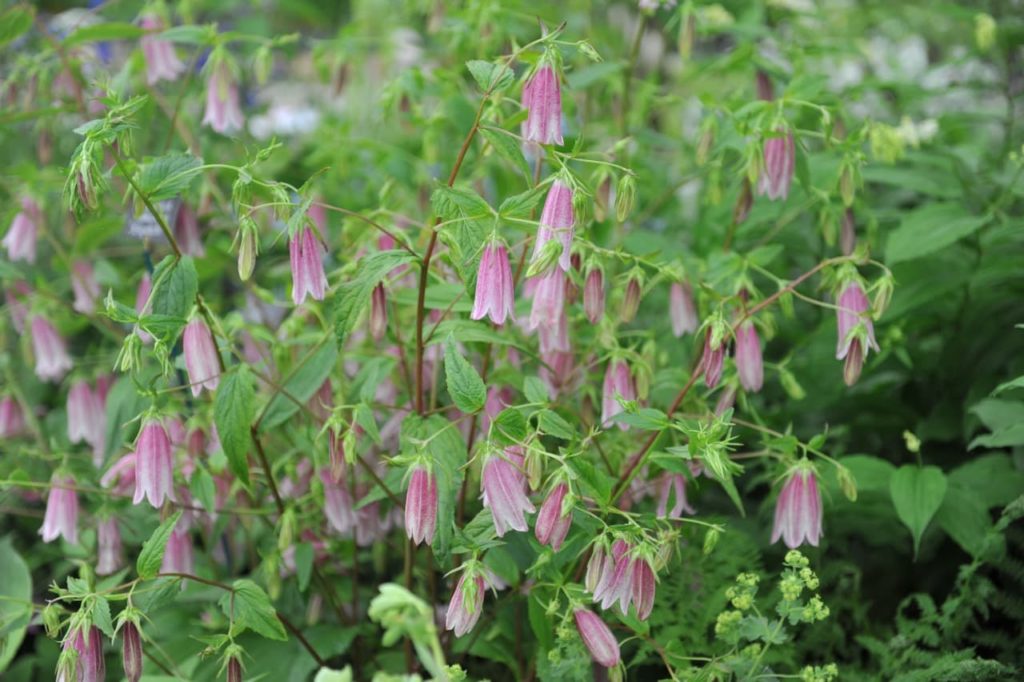
- COMMON NAME(S): bellflower
- HARDINESS RATING: H5-H7
- FOLIAGE: varies
- FLOWERS: blue, purple, pink and white
- SUNLIGHT: full sun / part shade
Campanula are another slug-safe plant to consider.
There are both annuals and perennials in this genus, some growing very tall and others great for ground cover, so you may well find several varieties that slugs won’t eat that are suited to your garden and your design needs.
9) Cichorium endivia
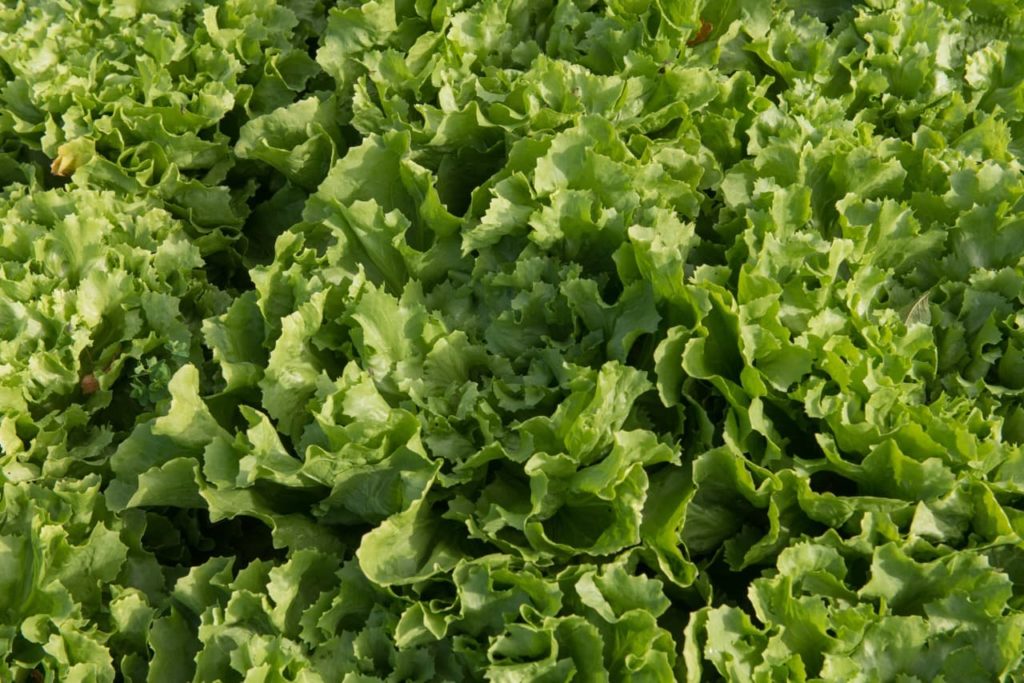
- COMMON NAME(S): endive
- HARDINESS RATING: H6
- FOLIAGE: evergreen
- FLOWERS: blue
- SUNLIGHT: full sun
An edible that produces tasty green leaves, this plant is best grown in full sun and is typically avoided by slugs and snails.
10) Symphytum officinale
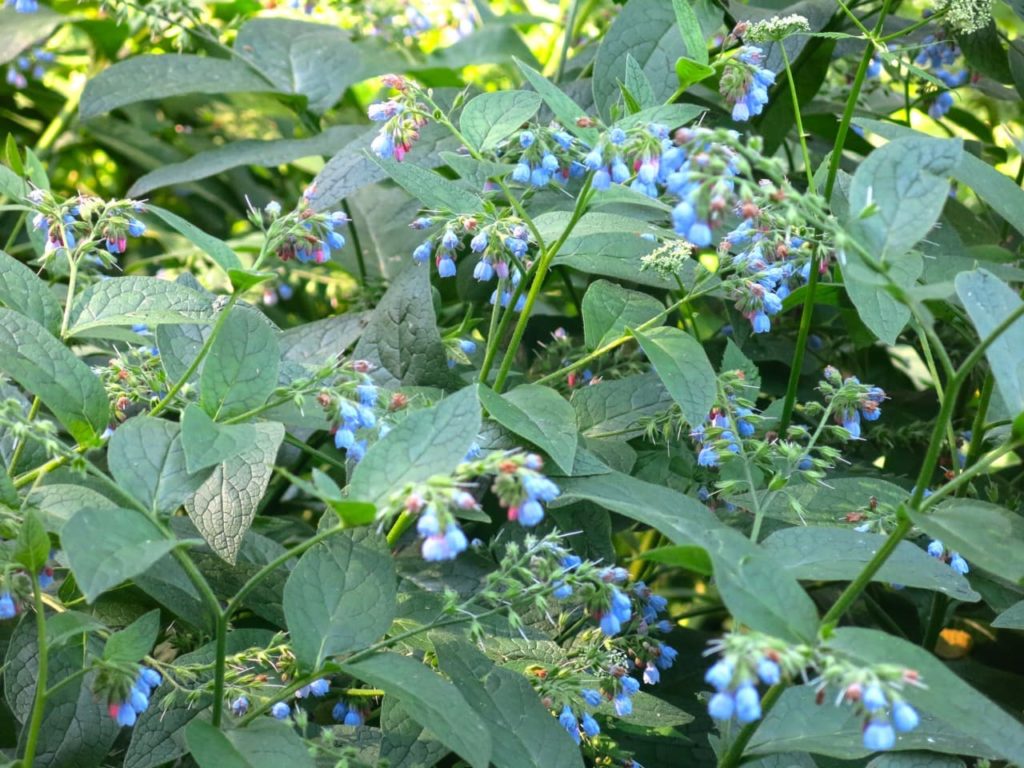
- COMMON NAME(S): common comfrey
- HARDINESS RATING: H7
- FOLIAGE: deciduous
- FLOWERS: cream, yellow, pink and purple
- SUNLIGHT: full sun / part shade
This is a plant I grow extensively for making homemade fertiliser.
I find that Comfrey may occasionally have a little slug damage but most commonly, this is another plant that slugs will tend to avoid in favour of more tender-leaved plants.
It can be useful in a garden in many different ways and can also be used as a mulch or liquid feed material.
11) Cyclamen hederifolium
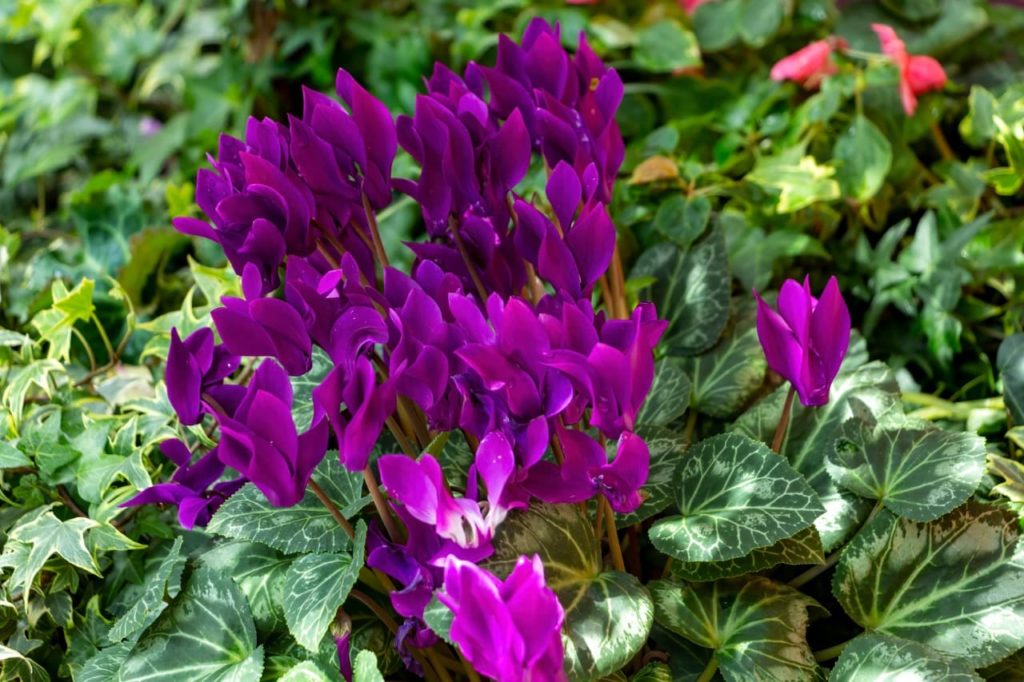
- COMMON NAME(S): ivy-leaved cyclamen
- HARDINESS RATING: H5
- FOLIAGE: deciduous
- FLOWERS: pink
- SUNLIGHT: part shade
These hardy cyclamen flowers in the early spring and in the late autumn when there is little else in bloom.
They are another excellent choice, even for slug-infested zones underneath trees or shrubs or in a shady garden border.
12) Digitalis purpurea
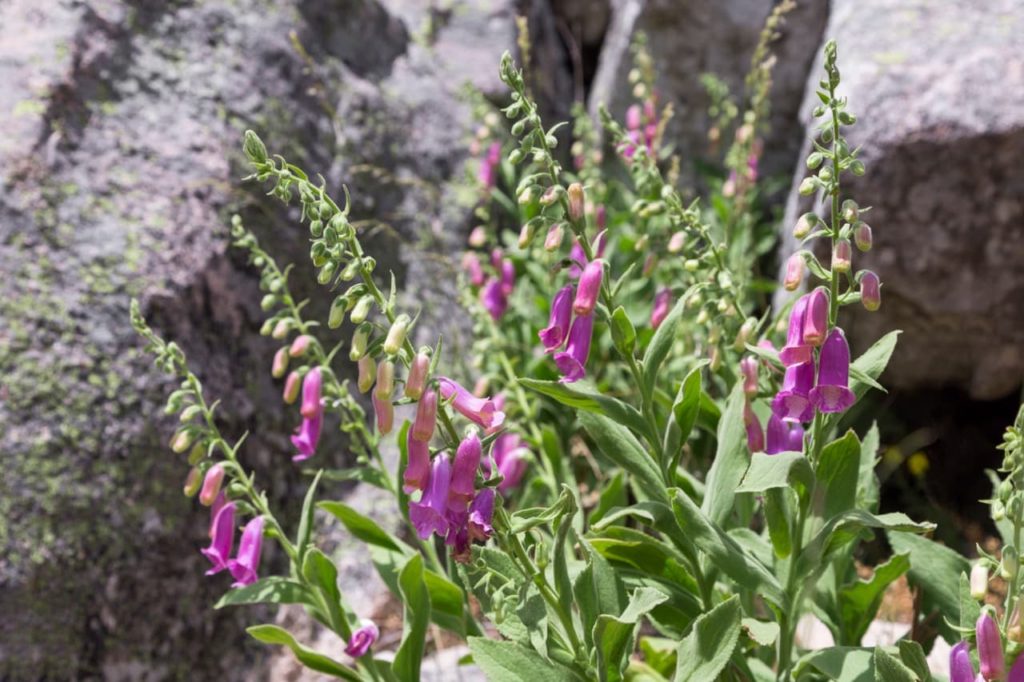
- COMMON NAME(S): common foxglove
- HARDINESS RATING: H7
- FOLIAGE: deciduous
- FLOWERS: purple
- SUNLIGHT: full sun / part shade
Foxgloves are not only unpalatable for slugs, but can actually be toxic to them.1Wong, J. (2018, June 10). Outwit your slugs: choose the plants they hate. The Guardian. Retrieved June 9, 2023, from https://www.theguardian.com/lifeandstyle/2018/jun/10/outwit-your-slugs-choose-the-plants-they-hate
Slugs will avoid eating the leaves – so any foxgloves, even in a slug-infested garden, will usually be entirely safe.
13) Erigeron karvinskianus

- COMMON NAME(S): Mexican fleabane
- HARDINESS RATING: H5
- FOLIAGE: semi-evergreen
- FLOWERS: pink, purple and white
- SUNLIGHT: full sun
With daisy-like blooms, Mexican Fleabanes make great ground cover plants and are usually avoided by pesky slugs.
14) Euphorbia
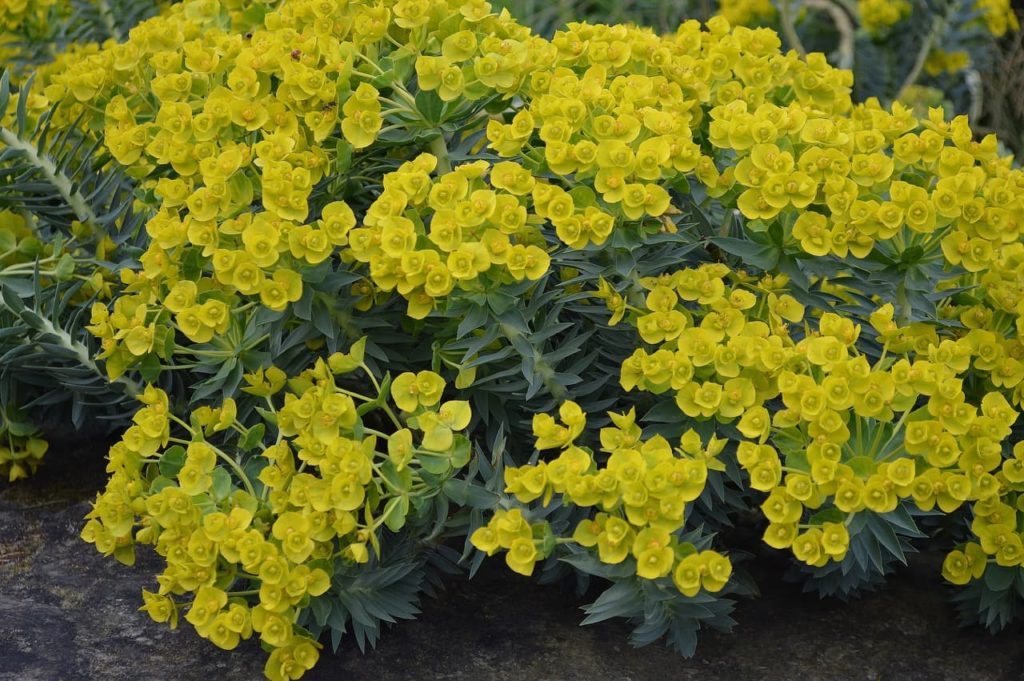
- COMMON NAME(S): spurge
- HARDINESS RATING: varies
- FOLIAGE: varies
- FLOWERS: varies
- SUNLIGHT: full sun / part shade / full shade
Euphorbias are not eaten by slugs, as they exude a milky sap that seems to be unpalatable to slugs.2Keep Away From Spurge Sap. (n.d.). Poison Control. Retrieved June 9, 2023, from https://www.poison.org/articles/keep-away-from-spurge-sap-222
There are a huge range of different Euphorbias that you might consider growing in your garden.
15) Ferns
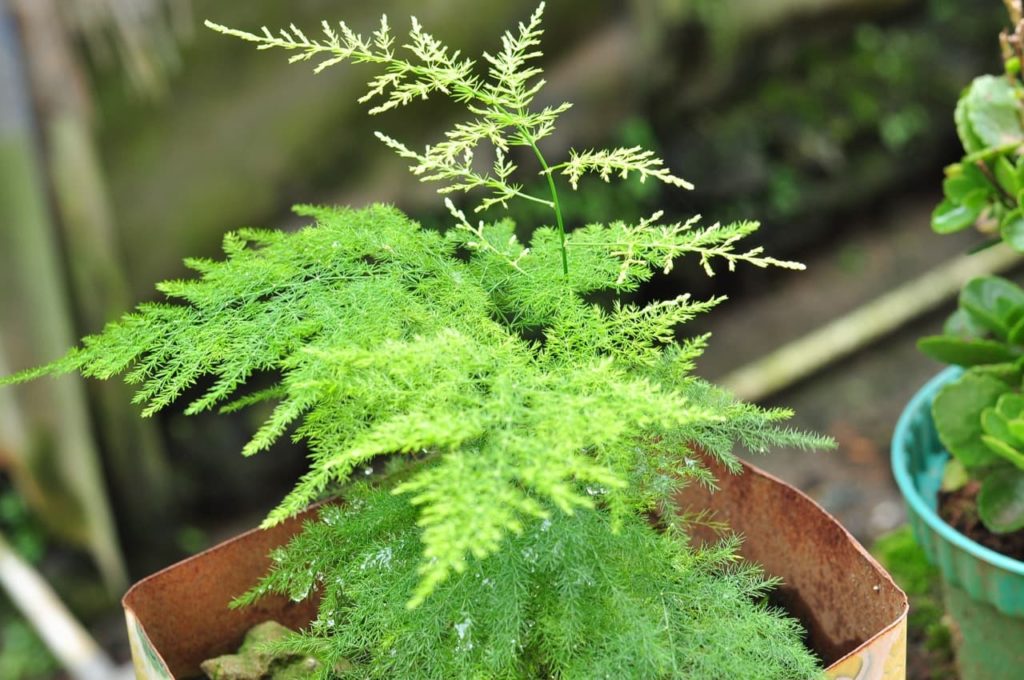
- COMMON NAME(S): fern
- HARDINESS RATING: varies
- FOLIAGE: mainly evergreen
- SUNLIGHT: part shade / full shade
Many ferns, of course, love shady and moist environments where slugs will also thrive.
Fortunately, ferns will typically not be bothered by slugs or snails at all and can be excellent low-maintenance choices for the right spot.
16) Fuchsia
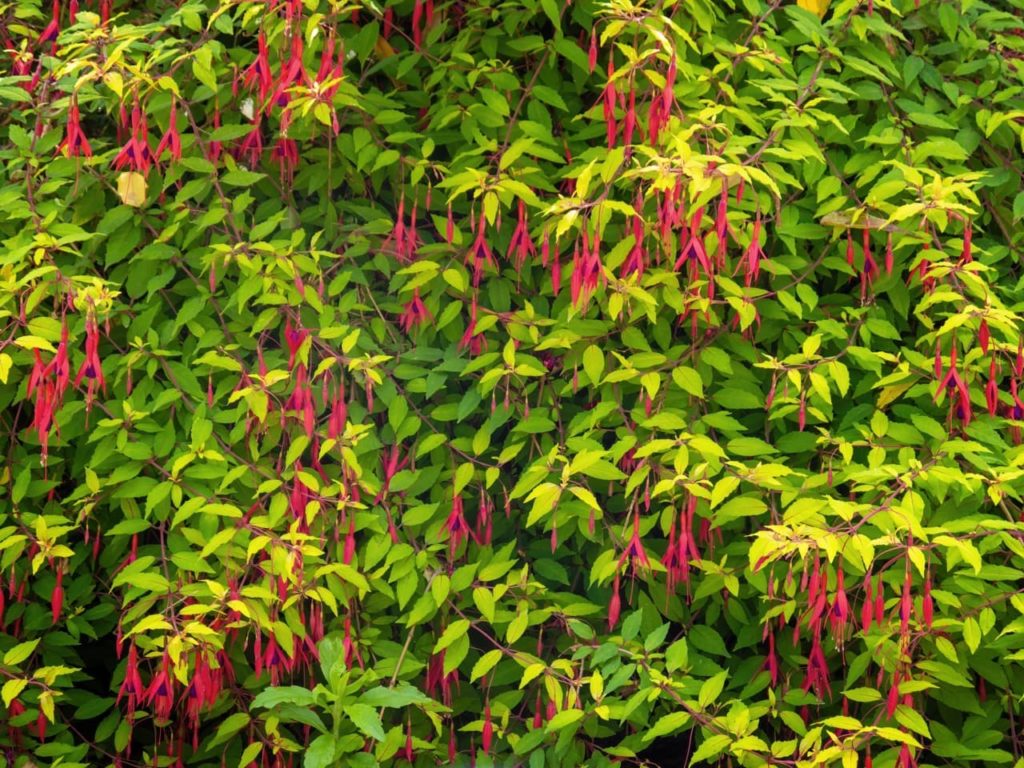
- COMMON NAME(S): fuchsia
- HARDINESS RATING: varies
- FOLIAGE: deciduous or semi-evergreen
- FLOWERS: varies
- SUNLIGHT: full sun or part shade
Large or small, Fuchsias are another plant unpalatable to slugs.
There are, of course, different fuchsias to choose from, some hardier and some tender, but I find that all of them tend to be more or less ignored by these slimy pests.
17) Geranium
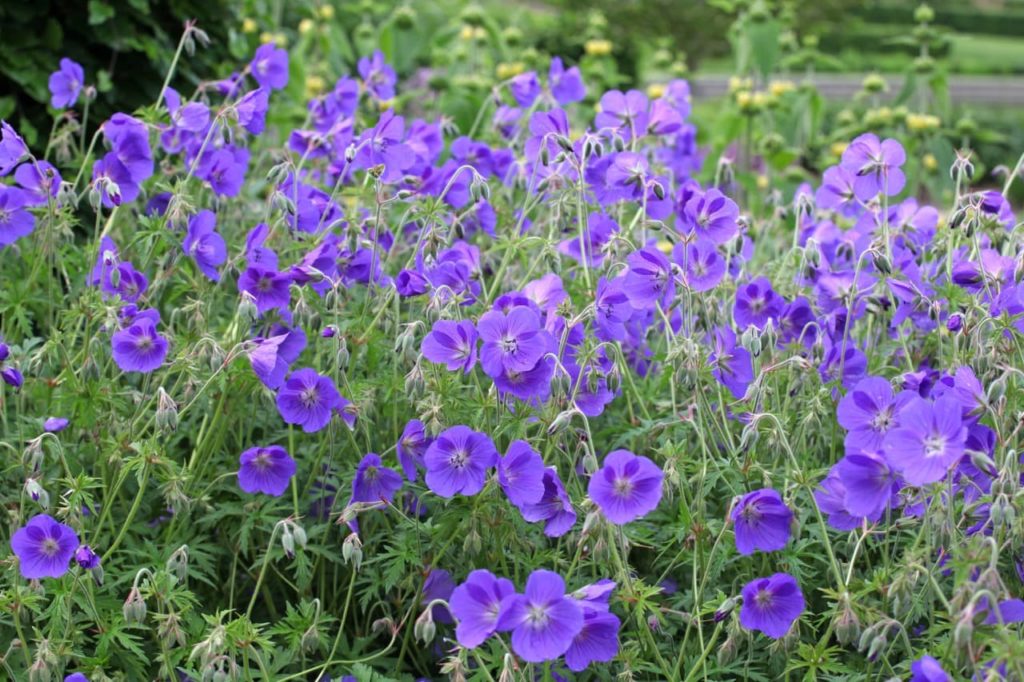
- COMMON NAME(S): cranesbill
- HARDINESS RATING: H6-H7
- FOLIAGE: deciduous
- FLOWERS: varies
- SUNLIGHT: full sun / part shade
Hardy geraniums, also known as Cranesbills, are another type of flowering plant that slugs will tend to avoid.
And, since these can be such hardy and reliable plants, there will definitely be at least one variety to suit your particular garden conditions.
Planting these as ground cover below and around susceptible plants can often help to keep them safe.
18) Hellebore
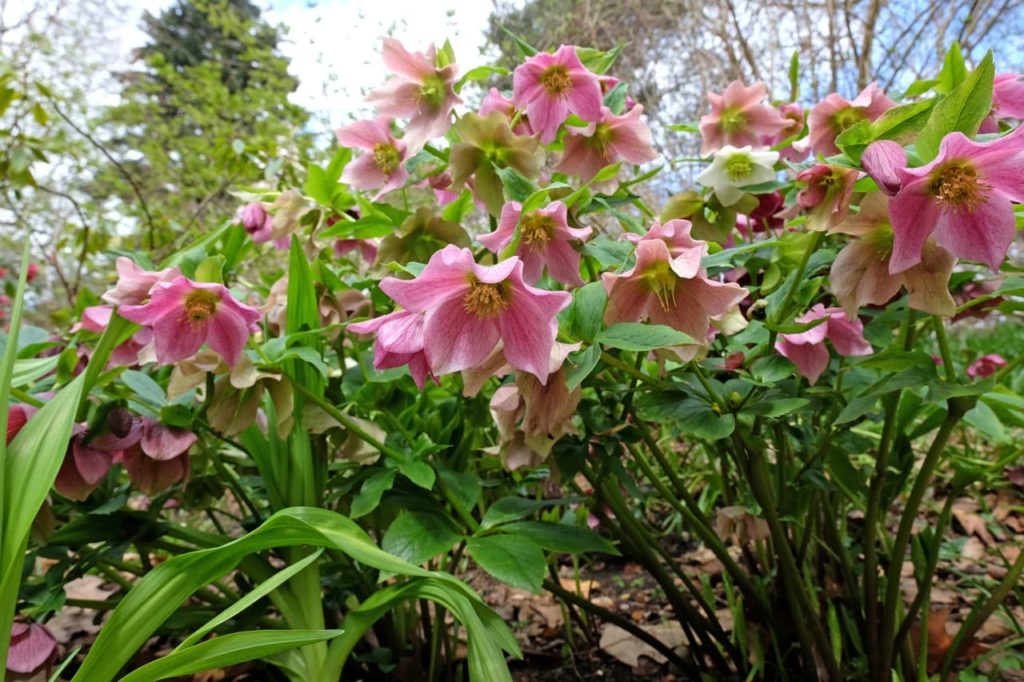
- COMMON NAME(S): Christmas rose
- HARDINESS RATING: H7
- FOLIAGE: semi-evergreen or deciduous
- FLOWERS: varies
- SUNLIGHT: varies
There are many different Hellebores that you might consider growing in your garden for blooms over the winter months.
Helleborus x hybridus with its large, leathery leaves, is one choice that will not typically be bothered by slugs.
19) Heuchera
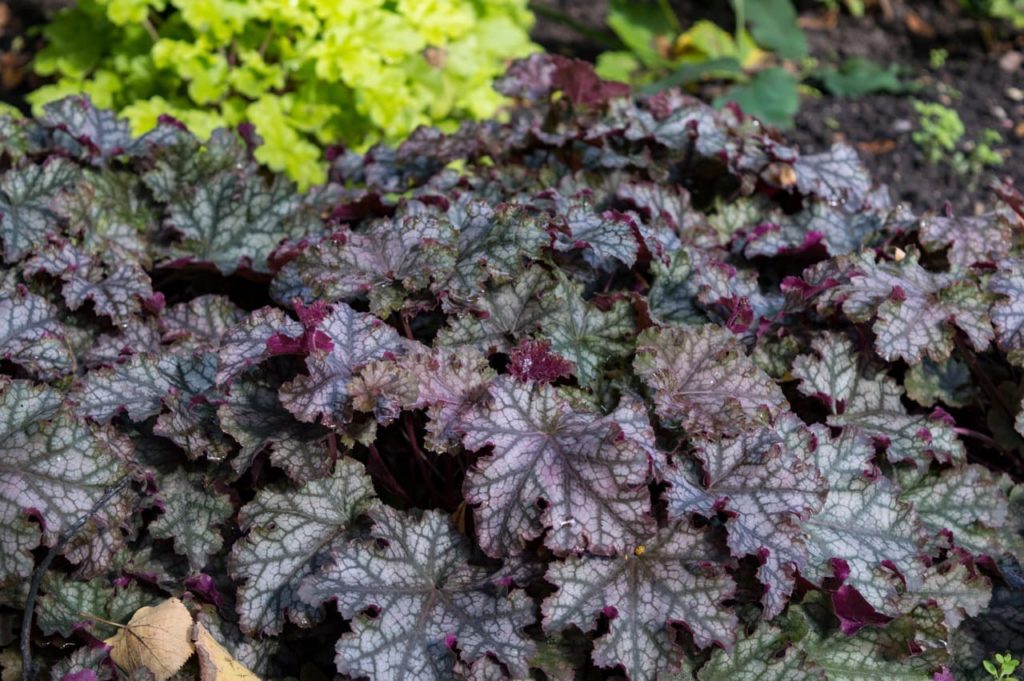
- COMMON NAME(S): coral bells
- HARDINESS RATING: H6
- FOLIAGE: evergreen
- FLOWERS: varies
- SUNLIGHT: full sun
Also known as Coral Bells, Heucheras are practically slug-proof.
These foliage plants can be wonderfully attractive throughout the year and many also have attractive flowering spikes in the summer.
20) Hydrangea anomala subsp. petiolaris
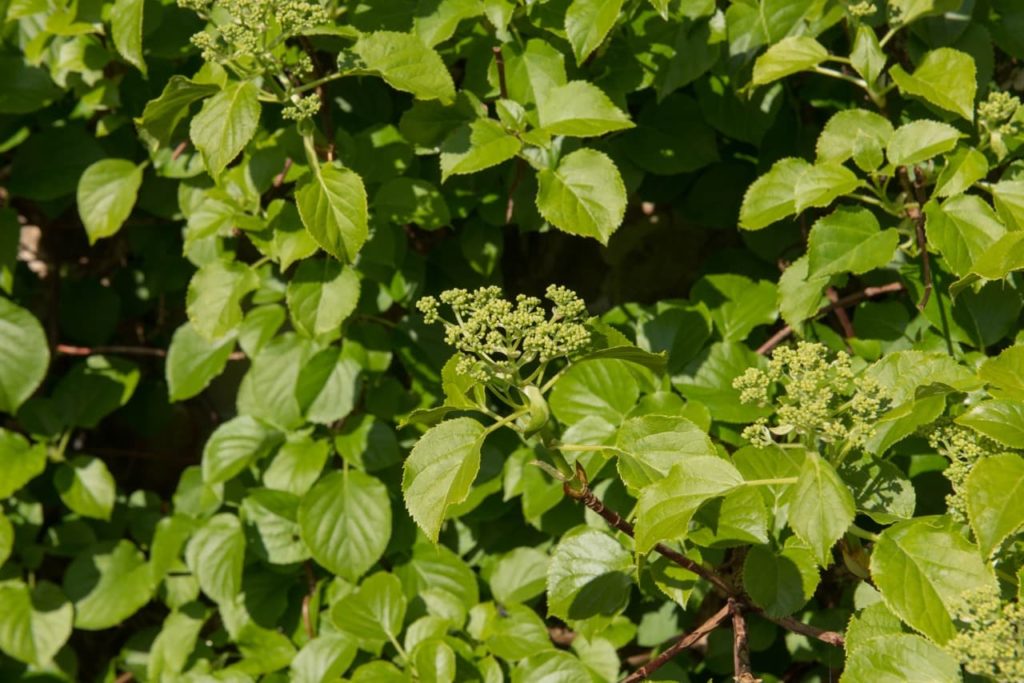
- COMMON NAME(S): climbing hydrangea
- HARDINESS RATING: H5
- FOLIAGE: deciduous
- FLOWERS: white
- SUNLIGHT: full sun / full shade / part shade
This Climbing Hydrangea is a great choice for covering a wall or fence – with the added benefit that it is also pretty much slug-proof and will not be eaten.
Other woody Hydrangeas are also on the longer list of many shrubs largely offputting to slugs.
21) Anemone japonica
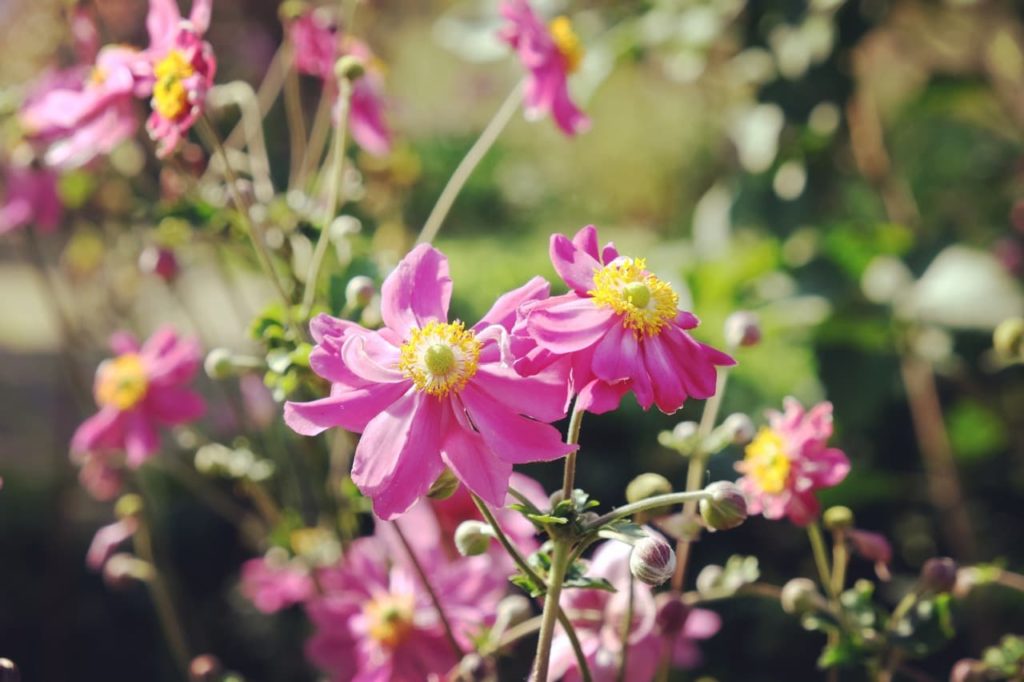
- COMMON NAME(S): Japanese anemone
- HARDINESS RATING: H7
- FOLIAGE: deciduous
- FLOWERS: pink and white
- SUNLIGHT: full sun / part shade
There are a number of Japanese Anemones that can make a good choice for ground cover – though they can be invasive in some soils and conditions, in which cases they may be best grown in containers.
22) Lavandula angustifolia
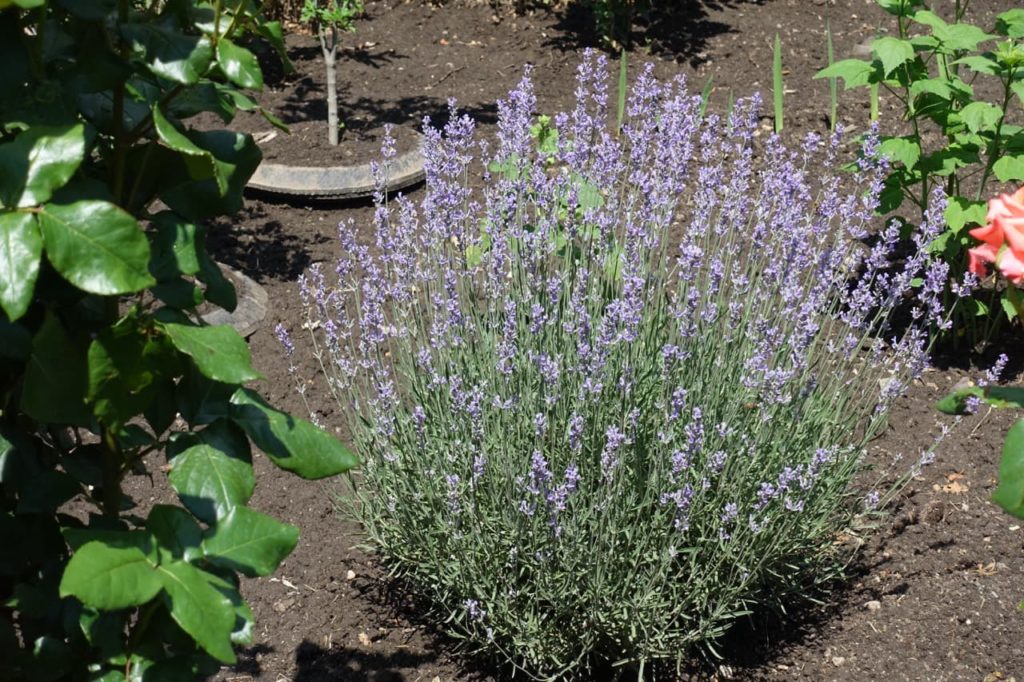
- COMMON NAME(S): English lavender
- HARDINESS RATING: H5
- FOLIAGE: evergreen
- FLOWERS: purple and blue
- SUNLIGHT: full sun
Like other shrubby, Mediterranean herbs, Lavender is not usually bothered by slugs or snails.
Both the woody growth habit and the oily, strong-tasting leaves make it one they will avoid.
So, this is a great choice if you have a suitable sunny and free-draining spot in which to grow it, either in containers or in the ground.
23) Tropaeolum majus
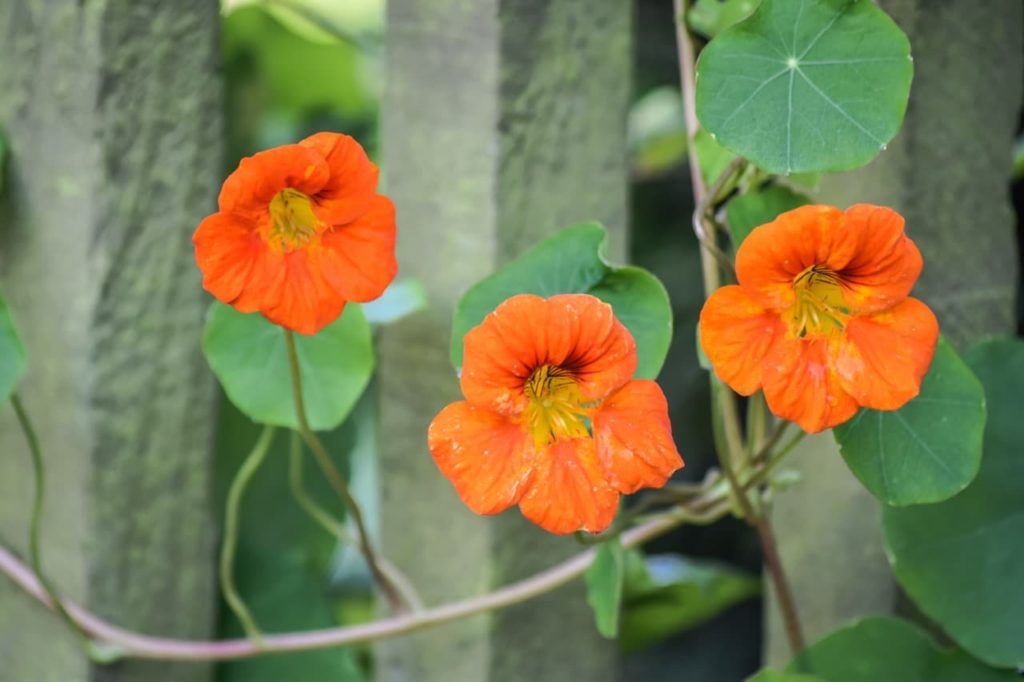
- COMMON NAME(S): nasturtium
- HARDINESS RATING: H3
- FOLIAGE: deciduous
- FLOWERS: orange, red and yellow
- SUNLIGHT: full sun
Nasturtiums make a great companion plant for a vegetable garden for a range of reasons, and one of those reasons is that slugs tend to avoid eating the peppery leaves, meaning that they are left for us to enjoy eating ourselves.
24) Penstemon
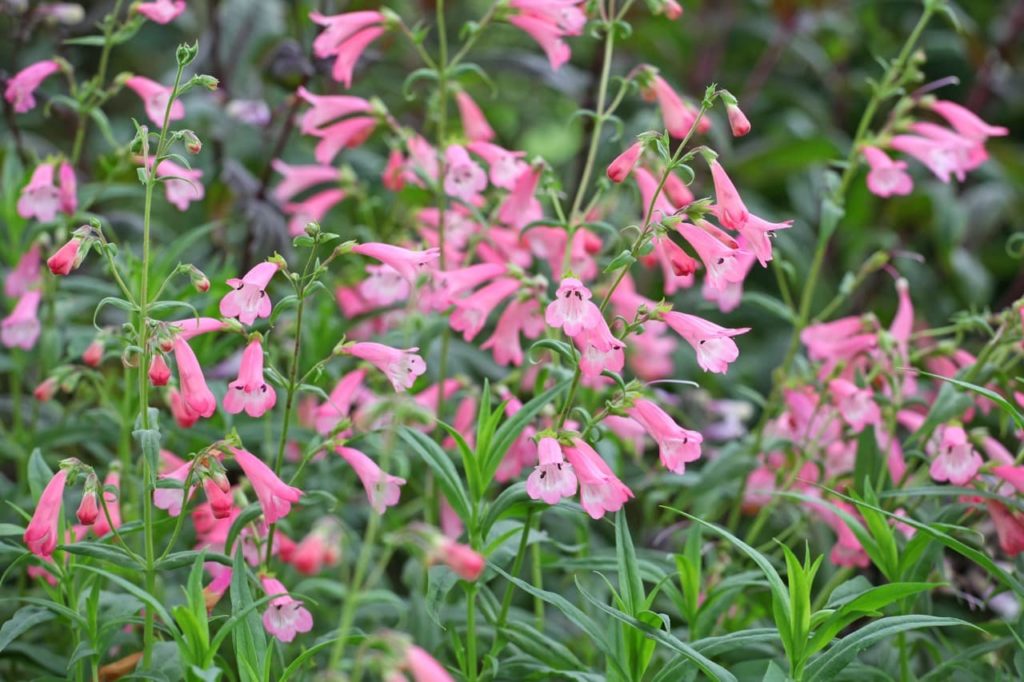
- COMMON NAME(S): Penstemon
- HARDINESS RATING: H3-H4
- FOLIAGE: varies
- FLOWERS: varies
- SUNLIGHT: full sun / part shade
Penstemons are wonderfully attractive foxglove-like flowers that can look great in many different beds and borders.
They are a staple of cottage gardens and while they’re very attractive to bumblebees, they will not attract slugs and should typically remain safe from their predations.
25) Pulmonaria

- COMMON NAME(S): lungwort
- HARDINESS RATING: H6
- FOLIAGE: deciduous
- FLOWERS: white, pink and blue
- SUNLIGHT: full sun / part shade
With their thick and hairy leaves, Pulmonaria tends not to be bothered by slugs either.
The adaptation of the leaves means that you can usually get away with growing these even where there are a lot of slugs around.
26) Salvia rosmarinus
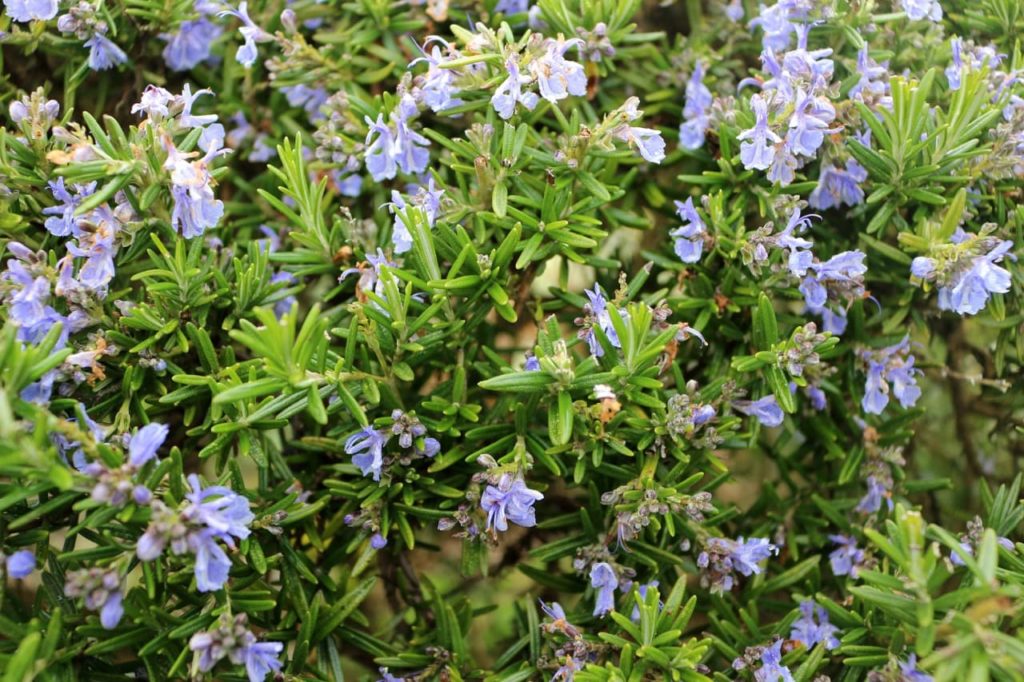
- COMMON NAME(S): rosemary
- HARDINESS RATING: H4
- FOLIAGE: evergreen
- FLOWERS: blue, purple and white
- SUNLIGHT: full sun
Another herb for your Mediterranean herb garden, rosemary is another practically bullet-proof plant that should help keep slugs away.
As long as you provide it with deep soil, free-draining conditions and enough sun, it should be an easy and relatively low-maintenance plant to grow.
27) Saxifraga × urbium
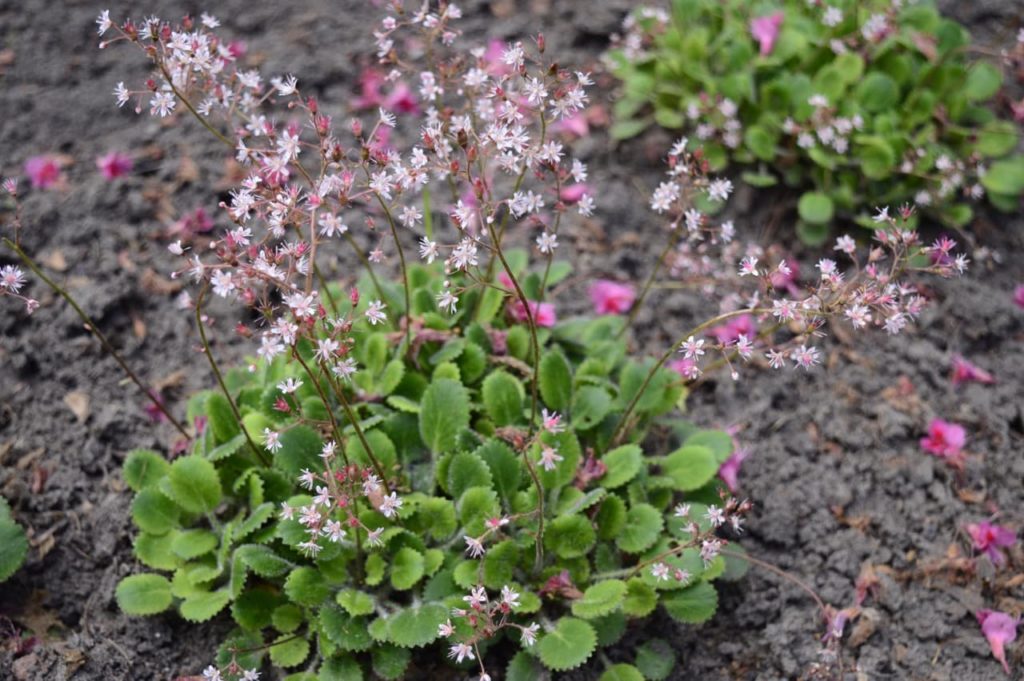
- COMMON NAME(S): London pride
- HARDINESS RATING: H5
- FOLIAGE: evergreen
- FLOWERS: pink and white
- SUNLIGHT: full shade / part shade
This is a plant that slugs won’t tend to eat that can be planted to create ground cover around more vulnerable plants.
While protection definitely won’t be 100%, this should help at least to a degree with a mollusc problem.
28) Sedum
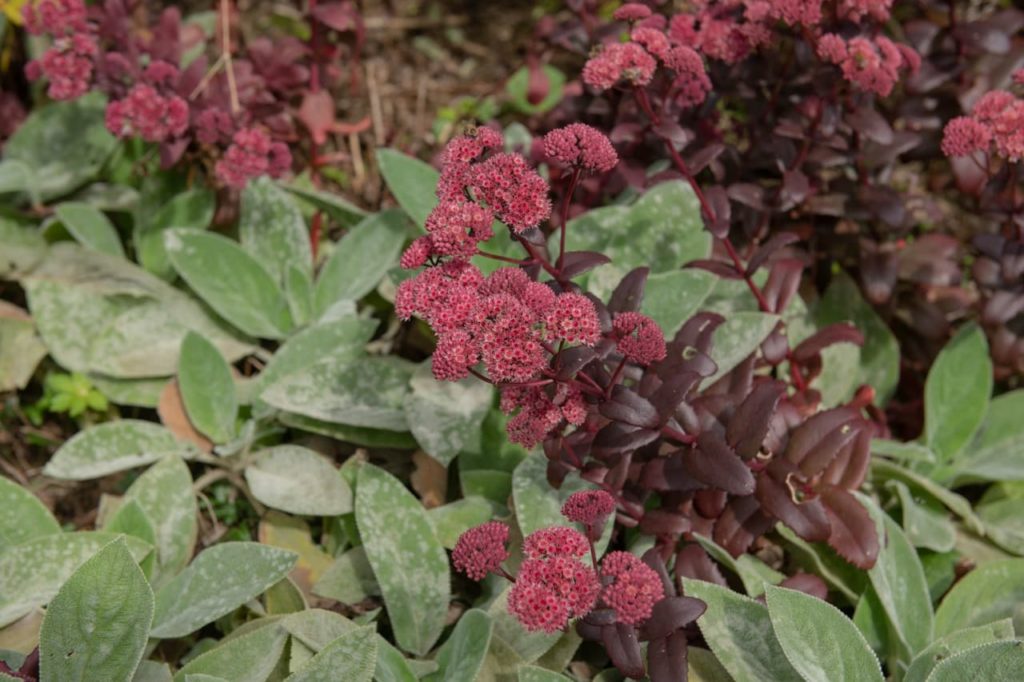
- COMMON NAME(S): stonecrop
- HARDINESS RATING: varies
- FOLIAGE: evergreen
- FLOWERS: varies
- SUNLIGHT: full sun
Sedums are one of a number of succulents that are also untroubled by slugs.
The large, swollen leaves of succulents are not ones that slugs will want to eat, so they will leave them alone.
29) Sempervivum
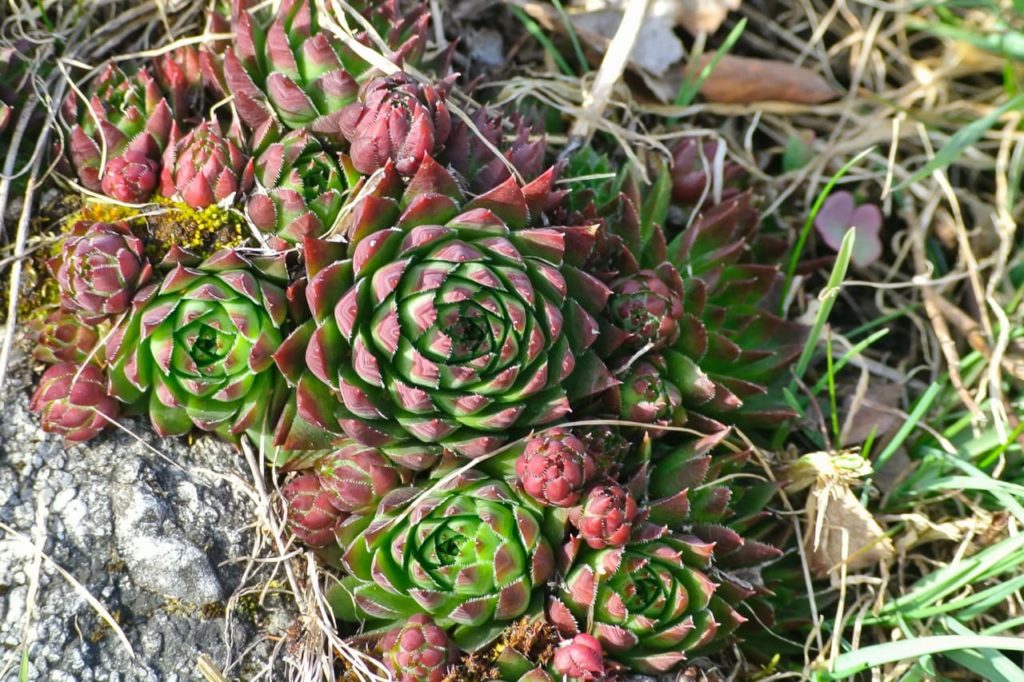
- COMMON NAME(S): houseleek
- HARDINESS RATING: H5-H7
- FOLIAGE: evergreen
- FLOWERS: pink and yellow
- SUNLIGHT: full sun
Sempervivums might also be grown in some gardens and are another type of succulent that slugs won’t eat.
So, where you have suitable growing conditions, growing succulents is another direction that you can take.
30) Stachys byzantina
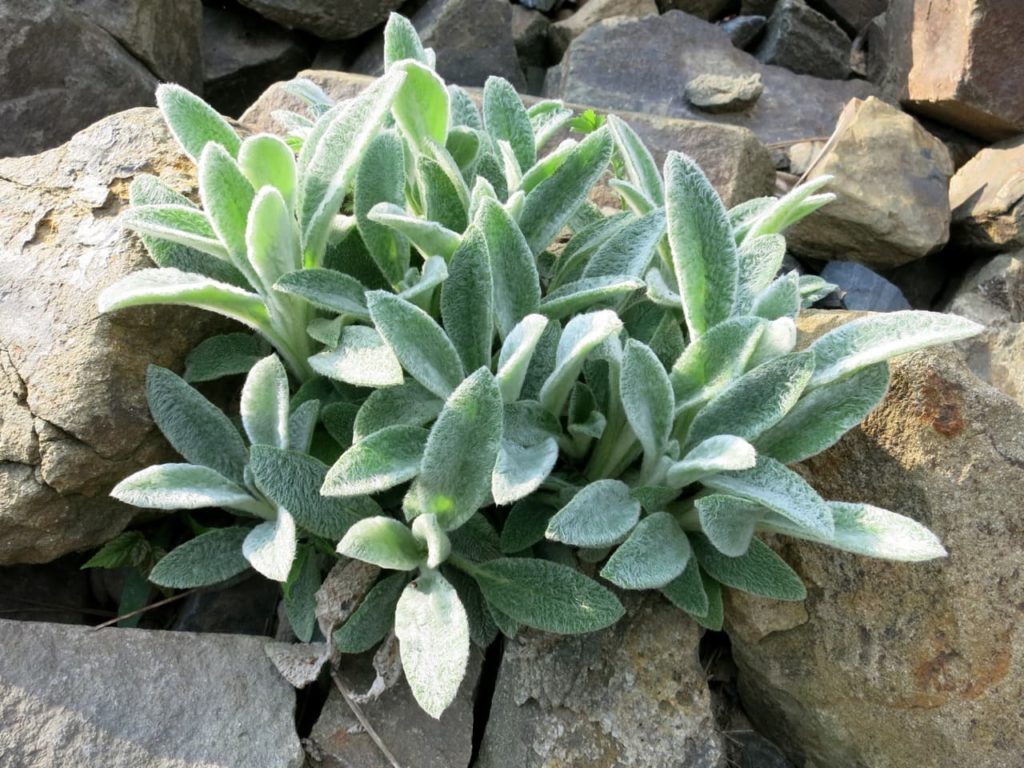
- COMMON NAME(S): lamb’s ear
- HARDINESS RATING: H7
- FOLIAGE: evergreen
- FLOWERS: purple
- SUNLIGHT: full sun
Also known as Lamb’s Ear, this tactile plant, with its fuzzy or woolly leaves, is a great choice for dry, gravel gardens, rockeries or other free-draining settings.
Wool carder bees use the hairs from the leaves to make their soft nesting chambers, but these same hairs keep slugs and snails away.
References
- 1Wong, J. (2018, June 10). Outwit your slugs: choose the plants they hate. The Guardian. Retrieved June 9, 2023, from https://www.theguardian.com/lifeandstyle/2018/jun/10/outwit-your-slugs-choose-the-plants-they-hate
- 2Keep Away From Spurge Sap. (n.d.). Poison Control. Retrieved June 9, 2023, from https://www.poison.org/articles/keep-away-from-spurge-sap-222
